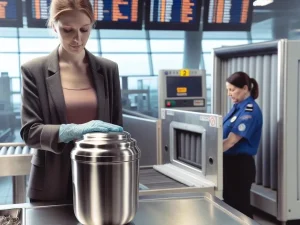Can You Transport Ashes on a Plane?
Yes, you can transport ashes on a plane, but it’s essential to follow airline regulations and TSA guidelines for respectful transportation and security compliance.
Understanding Cremated Remains
Cremated remains, often referred to as ashes, are the result of the cremation process, consisting of bone fragments reduced to fine particles for memorialization.
What Are Cremated Remains?
Cremated remains are the result of the cremation process, where a deceased individual’s body is subjected to intense heat, reducing it to ash and bone fragments. These remains typically consist of fine particles and may include small bone fragments, which can vary in color and texture. The final product is often stored in an urn, designed for memorialization. Families may choose to keep these remains at home, scatter them in meaningful locations, or use them in memorial services. Understanding cremated remains helps families navigate the emotional aspects of grief support, as well as the practicalities of transporting ashes during travel, whether domestic flights or international journeys, in accordance with airline regulations and legal requirements.
Common Practices for Handling Ashes
When handling ashes, families often engage in several common practices that honor the deceased. Firstly, securing cremated remains in a durable urn is essential for transportation, especially during air travel. Many choose urns designed specifically for travel, ensuring they meet airline regulations. Additionally, some families opt for scattering ashes in meaningful locations, often accompanied by memorial services that celebrate the loved one’s life. Others may choose to keep the ashes at home or place them in a columbarium. Regardless of the method, it’s important to understand the legal requirements for transporting ashes, whether traveling domestically or internationally, to ensure respectful transportation and compliance with airline regulations and TSA guidelines.
Legal Requirements for Transporting Ashes
Transporting ashes requires understanding legal requirements, including documentation and regulations that vary by location, ensuring compliance during domestic and international air travel.
Understanding Cremation Policies
Cremation policies vary by region and institution, significantly influencing how ashes can be transported. It’s crucial to familiarize yourself with local regulations before traveling. Many funeral services provide guidance on the necessary documentation, such as a cremation certificate, which may be required for transport; Understanding these policies can help ensure a smooth process when carrying ashes on flights. Additionally, some airlines may have specific requirements regarding urn materials and sizes, making it essential to check their guidelines. Being informed about cremation policies allows families to honor their loved ones respectfully while adhering to legal requirements during both domestic and international travel, ensuring compliance with all necessary airline regulations.
Legal Regulations by Country
Legal regulations surrounding the transportation of ashes vary significantly from country to country, affecting how cremated remains can be carried. Some nations require permits or documentation, such as a death certificate or cremation authorization, to ensure compliance with local laws. For instance, countries like Canada and the United Kingdom have specific guidelines detailing what is necessary for traveling with ashes. In contrast, other countries may have more lenient rules. It’s essential for travelers to research the regulations of both the departure and destination countries, as failure to comply can result in confiscation of the remains or other legal complications. Understanding these regulations ensures respectful transportation during international travel.
Airline Regulations on Carrying Ashes
Airline regulations for carrying ashes require specific urn types, proper documentation, and adherence to size restrictions, ensuring compliance during air travel for cremated remains.
Domestic Flights: What You Need to Know
When transporting ashes on domestic flights, it’s essential to familiarize yourself with airline policies and regulations. Most airlines permit cremated remains in carry-on luggage, but specific requirements exist. Generally, ashes must be stored in an urn that can pass through airport security, which often means transparent or easily opened containers. Additionally, it’s advisable to keep all necessary documentation, such as the cremation certificate, readily accessible to present to airline personnel if requested. Before traveling, check the specific airline’s website for detailed guidelines regarding urn materials and size restrictions. Being well-prepared ensures a smooth travel experience while honoring the memory of your loved one respectfully during domestic air travel.
International Travel: Guidelines and Restrictions
Transporting ashes internationally requires careful consideration of specific guidelines and restrictions imposed by various countries. Each nation has its own regulations regarding the importation of cremated remains, often necessitating permits or documentation such as a cremation certificate or death certificate. Before traveling, it’s crucial to research both the departure and destination countries’ legal requirements to ensure compliance. Additionally, airlines may have specific rules concerning the type of urns permitted, so verifying these details beforehand is essential. Travelers should also be prepared for potential customs inspections upon arrival. Being informed and organized helps ensure respectful transportation of ashes during international travel, allowing families to honor their loved ones across borders.
TSA Guidelines for Traveling with Ashes
The TSA guidelines for traveling with ashes emphasize using proper urns, ensuring documentation is available, and following security procedures for transporting cremated remains.
Transporting Ashes in Carry-On Luggage
When transporting ashes in carry-on luggage, it is crucial to follow TSA guidelines to ensure a smooth travel experience. First, select a suitable urn that is both secure and easily accessible for airport security checks. Many travelers prefer urns made from lightweight materials that comply with airline regulations. Additionally, keep the cremation certificate and any necessary documentation readily available, as airport security personnel may request to see them. It’s advisable to inform the airline about your intentions to carry ashes, ensuring they have no specific restrictions. Finally, consider packing the urn with care, cushioning it to avoid damage during transit, while maintaining respect and dignity for the remains during the journey.
Airport Security Procedures for Cremated Remains
When traveling with cremated remains, understanding airport security procedures is essential for a seamless experience. Upon arriving at security checkpoints, inform the TSA officers that you are carrying ashes. This helps them handle your belongings with care. Be prepared for the urn to undergo additional screening, as it may require manual inspection. Ensuring the urn is easily accessible will facilitate this process. Additionally, avoid using urns made of materials that may raise security concerns, such as metal or ceramic, which could trigger alarms. Keep the cremation certificate and related documentation handy, as officers might ask to see them. Following these procedures ensures respectful transportation while adhering to security regulations during air travel.
Choosing the Right Urns for Travel
When selecting urns for travel, prioritize lightweight materials, durability, and compliance with airline regulations to ensure safe and respectful transportation of cremated remains.
Types of Urns Suitable for Air Travel
When choosing urns for air travel, several types are particularly suitable. Lightweight materials such as biodegradable options, plastic, or thin metal are ideal because they are both durable and easy to handle. Biodegradable urns, often made from materials like paper or cornstarch, are environmentally friendly and may be preferred for scattering ashes. Additionally, travel urns designed specifically for flights often feature secure closures and compact designs, making them airport-friendly. It’s essential to avoid heavy or ornate urns that could raise security concerns or be cumbersome during transport. Ultimately, selecting the right urn ensures compliance with airline regulations while honoring the memory of your loved one respectfully during air travel.
Features to Look for in Travel Urns
When selecting travel urns for transporting ashes, several key features should be considered. First, look for durable materials that can withstand handling during transit, such as lightweight plastic or biodegradable options. A secure closure is crucial to prevent accidental spills, so ensure the urn has a reliable lid or seal. Additionally, consider the size of the urn, as it should comply with airline regulations regarding carry-on items. Compact and lightweight designs are preferable for ease of handling. Furthermore, some travel urns come with built-in identification tags or compartments for documentation, which simplifies the process during airport security checks. These features collectively enhance respectful transportation while ensuring compliance.
Shipping Ashes: Alternatives to Air Travel
Shipping ashes offers a practical alternative to air travel, ensuring compliance with legal requirements and providing options for respectful transportation without the complexities of airport security.
Understanding the Process of Shipping Ashes
Shipping ashes involves several important steps to ensure respectful and legal transportation. First, choose a reputable shipping service that specializes in transporting cremated remains, as they understand the specific legal requirements. Next, securely package the ashes in a durable urn, ensuring it meets shipping guidelines. Include all necessary documentation, such as a cremation certificate and any permits required by the destination country or state. It’s advisable to use a shipping method that allows for tracking, providing peace of mind during transit. Additionally, confirm the shipping policies of both the sending and receiving locations to ensure compliance. Following these steps helps facilitate a smooth process while honoring the memory of the deceased respectfully.
Legal Considerations for Shipping Cremated Remains
When shipping cremated remains, understanding the legal considerations is essential to ensure compliance and respect. Each country and state has specific regulations governing the transportation of ashes, often requiring documentation like a cremation certificate and permits. Check the laws of both the origin and destination locations to avoid any legal issues. Additionally, some shipping companies may have their own policies regarding the transportation of cremated remains, so it’s vital to choose a service experienced in this area. It’s also important to ensure that the urn used for shipping is sturdy and secure to prevent damage during transit. Ensuring all legal requirements are met facilitates a respectful and smooth shipping process.
Respectful Transportation of Ashes
Respectful transportation of ashes involves understanding legal requirements, choosing appropriate urns, and following guidelines for handling cremated remains during air travel or shipping.
Best Practices for Honoring the Deceased
When transporting ashes, following best practices is essential to honor the deceased respectfully. First, choose a dignified urn that reflects the personality or preferences of your loved one. Next, ensure all necessary documentation, such as the cremation certificate, is organized and readily accessible. During travel, handle the urn with care, treating it as a treasured keepsake. If traveling by air, inform airline staff about the ashes to ensure proper handling. Additionally, consider involving family members in the process, allowing them to share memories and express their grief together. Finally, upon arrival, plan a meaningful memorial or scattering ceremony to commemorate the deceased appropriately, celebrating their life and legacy in a heartfelt manner.
Grief Support During the Journey
Transporting ashes can be an emotionally challenging experience, making grief support vital during the journey. First, acknowledge your feelings and allow yourself to grieve, as this process is essential for healing. Sharing your emotions with family or friends traveling with you can provide comfort and understanding. Additionally, consider seeking support from grief counselors or support groups, either in person or online, who can offer guidance and understanding. Journaling your thoughts or creating a memory book can also help process emotions. Furthermore, planning memorial activities or ceremonies during the journey allows you to honor your loved one while fostering a sense of connection. Prioritizing self-care ensures you navigate this journey with compassion and support.
Memorial Services and Scattering Ashes
Memorial services and scattering ashes allow families to honor their loved ones, creating meaningful tributes while ensuring respectful transportation of cremated remains during air travel.
Planning a Memorial Service After Transportation
Planning a memorial service after transporting ashes involves thoughtful consideration to create a meaningful tribute. Start by selecting a suitable location that holds significance for the deceased or their family. This could be a home, park, or place of worship. Next, consider the preferred format of the service, whether formal or informal, and the inclusion of personal touches, such as favorite songs, readings, or photos. Involve family members in the planning process to ensure everyone feels represented and included. Additionally, think about incorporating rituals, such as lighting candles or sharing memories, to foster connection among attendees. Finally, communicate details to guests clearly, ensuring a respectful and memorable service that honors the loved one’s legacy.
Scattering Ashes: Legal and Practical Considerations
Scattering ashes involves both legal and practical considerations that must be addressed to ensure a respectful process. First, check local laws and regulations regarding scattering ashes, as some places may require permits or have specific guidelines. National parks or private property may have restrictions, so obtaining permission is essential. Practically, choose a location that holds significance for the deceased or family, ensuring a meaningful experience. When planning the scattering, consider the weather and time of day to create a serene atmosphere. Additionally, involve family members or close friends in the ceremony, allowing everyone to share thoughts and memories. Ultimately, following these considerations ensures a respectful and heartfelt tribute to honor your loved one.
Burial at Sea: A Unique Option
Burial at sea offers a unique option for honoring loved ones, requiring specific regulations and planning to ensure respectful transportation and compliance with legal requirements.
Legal Requirements for Burial at Sea
Burial at sea involves specific legal requirements that must be adhered to for a respectful and compliant process. First, it is essential to check the regulations within your country, as different nations have varying laws concerning the scattering of ashes in marine environments. In the United States, for instance, the Environmental Protection Agency (EPA) requires that remains are scattered at least three nautical miles from shore. Additionally, a permit may be necessary for conducting a burial at sea, which can be obtained through local authorities. Proper documentation, including a cremation certificate, should be readily available. Following these legal requirements ensures the ceremony is conducted respectfully, honoring the deceased in accordance with the law.
Preparing for a Sea Burial
Preparing for a sea burial requires thoughtful planning to ensure a respectful and meaningful ceremony. Begin by selecting a suitable location that complies with legal requirements, ensuring it is at least three nautical miles from shore if in the U.S. Next, coordinate logistics, such as securing a boat or charter service experienced in conducting sea burials. Consider involving family and friends in the planning process to create a shared experience, allowing everyone to contribute personal touches. Prepare an urn that is biodegradable or specifically designed for sea burials, ensuring it complies with environmental guidelines. Finally, plan the ceremony details, including readings, music, and rituals, creating a heartfelt tribute that honors the deceased appropriately during this unique farewell.














Post Comment